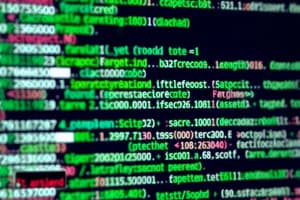Podcast
Questions and Answers
What is the primary purpose of Divide and Conquer technique in algorithm design?
What is the primary purpose of Divide and Conquer technique in algorithm design?
- To develop Backtracking algorithms
- To break down complex problems into smaller sub-problems (correct)
- To implement algorithms using Dynamic Programming
- To solve problems using a Greedy approach
What is the main feature of Pseudocode?
What is the main feature of Pseudocode?
- It is a compiled language
- It is a low-level assembly language
- It is a high-level programming language
- It is a simple syntax, easy to read and write, and language-independent (correct)
What is the purpose of Conditional Statements in programming?
What is the purpose of Conditional Statements in programming?
- To jump to a specific location in the program
- To declare variables
- To iterate through a block of code
- To execute different blocks of code based on conditions or predicates (correct)
What is the primary function of Control Structures in programming?
What is the primary function of Control Structures in programming?
What is the purpose of a Loop Control Variable in an Iteration?
What is the purpose of a Loop Control Variable in an Iteration?
What is the main difference between a While loop and a Do-While loop?
What is the main difference between a While loop and a Do-While loop?
What is being evaluated in the switch statement based on the code snippet provided?
What is being evaluated in the switch statement based on the code snippet provided?
What region is represented by a ZIP code starting with 7?
What region is represented by a ZIP code starting with 7?
What is an alternative approach to finding the maximum among 3 values?
What is an alternative approach to finding the maximum among 3 values?
In a while loop, the loop body must be indented.
In a while loop, the loop body must be indented.
In a do-while loop, the loop body is executed at least ______.
In a do-while loop, the loop body is executed at least ______.
Flashcards are hidden until you start studying
Study Notes
Algorithm Design
- Problem-solving approach:
- Understand the problem
- Break down into smaller sub-problems
- Develop a step-by-step solution
- Implement and test the solution
- Algorithm design techniques:
- Divide and Conquer
- Dynamic Programming
- Greedy Algorithms
- Backtracking
Pseudocode
- Definition: A high-level representation of a programming algorithm using structured English-like syntax
- Purpose: To design, test, and communicate algorithms without worrying about specific programming languages
- Features:
- Simple syntax
- Easy to read and write
- Language-independent
Conditional Statements
- Definition: Statements that execute different blocks of code based on conditions or predicates
- Types:
- If-Then statements
- If-Then-Else statements
- Switch statements (or Case statements)
- Logical Operators:
- AND (&&)
- OR (||)
- NOT (!)
Control Structures
- Definition: Statements that control the flow of program execution
- Types:
- Conditional Statements (If-Then, If-Then-Else, Switch)
- Loops (For, While, Do-While)
- Jump Statements (Break, Continue, Return)
- Purpose: To alter the normal flow of program execution based on conditions, iterations, or jumps
Iterations (Loops)
- Definition: Statements that execute a block of code repeatedly for a specified number of iterations
- Types:
- For loops
- While loops
- Do-While loops
- Loop Control Variables:
- Initialization
- Condition
- Increment/Decrement
Algorithm Design
- Algorithm design involves a problem-solving approach that includes understanding the problem, breaking it down into smaller sub-problems, developing a step-by-step solution, implementing, and testing the solution
- Techniques used in algorithm design include Divide and Conquer, Dynamic Programming, Greedy Algorithms, and Backtracking
Pseudocode
- Pseudocode is a high-level representation of a programming algorithm using structured English-like syntax
- Its purpose is to design, test, and communicate algorithms without worrying about specific programming languages
- Pseudocode features simple syntax, is easy to read and write, and is language-independent
Conditional Statements
- Conditional statements execute different blocks of code based on conditions or predicates
- Types of conditional statements include If-Then statements, If-Then-Else statements, and Switch statements (or Case statements)
- Logical operators used in conditional statements include AND (&&), OR (||), and NOT (!)
Control Structures
- Control structures alter the normal flow of program execution based on conditions, iterations, or jumps
- Types of control structures include Conditional Statements, Loops, and Jump Statements
- Conditional Statements include If-Then, If-Then-Else, and Switch statements
- Loops include For, While, and Do-While loops
- Jump Statements include Break, Continue, and Return statements
Iterations (Loops)
- Loops execute a block of code repeatedly for a specified number of iterations
- Types of loops include For loops, While loops, and Do-While loops
- Loop control variables involve Initialization, Condition, and Increment/Decrement
Problem Solving with Selection and Repetition Statements
- The objectives of this unit are:
- Using relational and logical operators
- Using selection statements to choose between two or more execution paths in a program
- Using repetition statements to repeat a segment of code
Control Structures
- There are two types of control flow:
- Sequential control flow: one statement after another
- Non-sequential control flow: statements can be executed or skipped based on conditions
Selection Structures
- C provides two control structures that allow the selection of a group of statements to be executed or skipped when certain conditions are met:
- if statement
- if-else statement
Conditional Expressions
- A condition is an expression evaluated to true or false
- Conditions are composed of expressions combined with relational operators
- Examples of relational operators:
- < (less than)
- > (greater than)
- >= (greater than or equal to)
- == (equal to)
- != (not equal to)
Logical Operators
- Complex conditions can be created by combining two or more boolean expressions using logical operators:
- && (and)
- || (or)
- ! (not)
Evaluation of Boolean Expressions
- The evaluation of a boolean expression is done according to the precedence and associativity of the operators
- Always add parentheses for readability
Caution
- Be careful when writing boolean expressions, as the values 0 and 1 are used to represent false and true respectively
- Avoid convoluted codes and use parentheses for readability
Short-Circuit Evaluation
- Short-circuit evaluation is used to avoid evaluating unnecessary expressions
- || (or) operator: if the first expression is true, skip evaluating the second expression and return true
- && (and) operator: if the first expression is false, skip evaluating the second expression and return false
if and if-else Statements
- Examples of if and if-else statements
- Use parentheses for readability
- Move common statements out of the if-else construct
Nested if and if-else Statements
- Nested if (if-else) structures refer to the containment of an if (if-else) structure within another if (if-else) structure
- Use parentheses and indentation to improve readability
Style Issues
- Indentation is important for readability
- Use consistent indentation and formatting
- Alternative indentation style for deeply nested if-else-if construct
- Name 'boolean' variables descriptively to improve readability### Naming Conventions for Boolean Flags
- Add suffixes such as "is" or "has" to names of boolean flags instead of just calling them "flag"
- Example: isEven, isPrime, hasError, hasDuplicates
Removing 'if' Statements with Assignment
- The if statement can be rewritten into a single assignment statement when the condition evaluates to 0 or 1
- Example:
isEven = (num % 2 == 0);
Common Errors
- Errors can be caught by the compiler or may go undetected
- Example: extra semicolon at the end of an if statement, incorrect indentation, mismatched else statement
The switch Statement
- Alternative to if-else-if statements
- Restriction: value must be of discrete type (e.g., int, char)
- Syntax:
switch (expression) { case value1: ...; break; ... default: ...; break; }
Testing and Debugging
- Test your programs thoroughly with your own data
- Do not rely on CodeCrunch to test your programs
- Example: finding the maximum value among three variables
The while Loop
- Syntax:
while (condition) { loop body } - Loop body is executed as long as the condition is true
- Example: keep prompting the user to input a non-negative integer and print the maximum integer input
The do-while Loop
- Syntax:
do { loop body } while (condition); - Loop body is executed at least once
- Example: count the number of digits in an integer
The for Loop
- Syntax:
for (initialization; condition; update) { loop body } - Example: print numbers 1 to 10
Studying That Suits You
Use AI to generate personalized quizzes and flashcards to suit your learning preferences.





